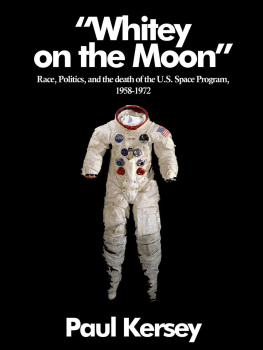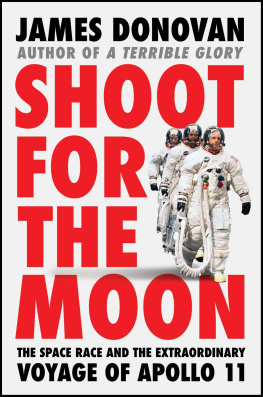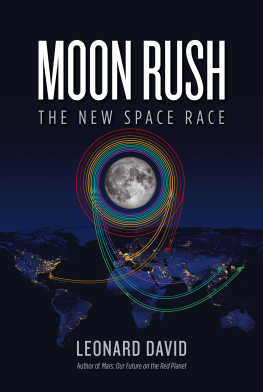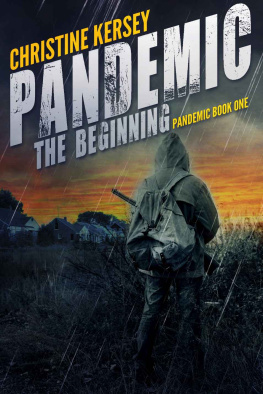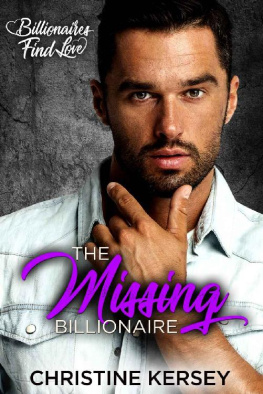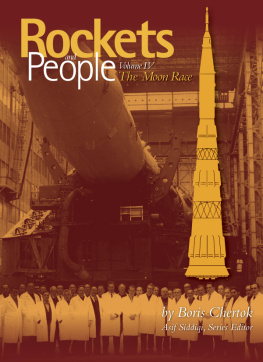Paul Kersey - ’Whitey on the Moon’: Race, Politics, and the death of the U.S. Space Program, 1958 - 1972
Here you can read online Paul Kersey - ’Whitey on the Moon’: Race, Politics, and the death of the U.S. Space Program, 1958 - 1972 full text of the book (entire story) in english for free. Download pdf and epub, get meaning, cover and reviews about this ebook. year: 2016, publisher: CreateSpace Independent Publishing Platform, genre: History. Description of the work, (preface) as well as reviews are available. Best literature library LitArk.com created for fans of good reading and offers a wide selection of genres:
Romance novel
Science fiction
Adventure
Detective
Science
History
Home and family
Prose
Art
Politics
Computer
Non-fiction
Religion
Business
Children
Humor
Choose a favorite category and find really read worthwhile books. Enjoy immersion in the world of imagination, feel the emotions of the characters or learn something new for yourself, make an fascinating discovery.
- Book:’Whitey on the Moon’: Race, Politics, and the death of the U.S. Space Program, 1958 - 1972
- Author:
- Publisher:CreateSpace Independent Publishing Platform
- Genre:
- Year:2016
- Rating:3 / 5
- Favourites:Add to favourites
- Your mark:
- 60
- 1
- 2
- 3
- 4
- 5
’Whitey on the Moon’: Race, Politics, and the death of the U.S. Space Program, 1958 - 1972: summary, description and annotation
We offer to read an annotation, description, summary or preface (depends on what the author of the book "’Whitey on the Moon’: Race, Politics, and the death of the U.S. Space Program, 1958 - 1972" wrote himself). If you haven't found the necessary information about the book — write in the comments, we will try to find it.
Paul Kersey: author's other books
Who wrote ’Whitey on the Moon’: Race, Politics, and the death of the U.S. Space Program, 1958 - 1972? Find out the surname, the name of the author of the book and a list of all author's works by series.
’Whitey on the Moon’: Race, Politics, and the death of the U.S. Space Program, 1958 - 1972 — read online for free the complete book (whole text) full work
Below is the text of the book, divided by pages. System saving the place of the last page read, allows you to conveniently read the book "’Whitey on the Moon’: Race, Politics, and the death of the U.S. Space Program, 1958 - 1972" online for free, without having to search again every time where you left off. Put a bookmark, and you can go to the page where you finished reading at any time.
Font size:
Interval:
Bookmark:
'Whitey on the Moon'
Race, Politics, and the death of the U.S. Space Program, 1958 - 1972
Paul Kersey
Copyright 2016 SBPDL
All rights reserved.
ISBN: 1519461267
ISBN-13: 978-1519461261
DEDICATION
To those who still look up at the stars and dream.
CONTENTS
Washington D.C.
March 6, 2016
Years ago, I was watching the Disney film Cant Buy Me Love (released in 1987) at a friends house. Whats seemingly a mid-1980s teenage romantic comedy has a poignant scene all the more melancholy when one watches it today.
Watching the movie in 1996 at my friends house, I was struck by the depth of a scene where the films stars, two white high school seniors, are starring up at the night sky. Ronald Miller (played by Patrick Dempsey) has a telescope and he is showing the captain of the cheerleading team Cindy - (portrayed by the late Amanda Peterson) the moon. The dialogue is so sad to read today, because when the movie came out, it had only been 18 years since man first stood on the moon:
Cindy- God. There are mountains up there. And valleys, canyons and plains. What's that thing, um, up there that looks like a star sapphire? What's that?
Ronald Tycho. An asteroid crashed there and broke the moon.
Cindy Broke the moon?
Ronald Yeah. It made a crack in the moon a hundred times the size of the Grand Canyon. On the right is the Sea of Tranquility. The First spaceship from Earth landed there the day I was born.
Cindy That's why you're so into astrology, right?
Ronald Astronomy. No. It's just... up there... is our future world. By the time I'm my dad's age, people will be living there and working. Maybe even us.
Cindy The moon. It looks different now. It's not as mysterious or romantic.
Ronald I'm sorry I ruined it for you.
Cindy You didn't ruin it. You just changed it, I guess.
In 2017, Cant Buy Me Love will turn 30. There is no one living and working on the moon. The United States of America cant even send men into space anymore, with the space shuttle retired in 2011. We have to hitch a ride with the Russians to get into space.
The Wright brothers first flew in Kitty Hawk, North Carolina in 1903, and only 66 years later man walked on the moon. Almost 47 years since this momentous occasion and acceleration in the evolution of mankind, the nation that gave birth to flight and sent men to the moon must rely on its Cold War adversary to get into space.
What happened?
Whitey on the Moon will tell the story of exactly what happened. Its not a pretty picture nor is it one many people would feel comfortably telling in public, because it requires being honest about the very subject we are most dishonest about: race and racial differences in intelligence.
Nearly 20 years after I first saw Cant Buy Me Love , I sat down in a movie theater to watch another Disney production, Tomorrowland .
The movie tells the story of a NASA engineer Frank Newton - who is tasked with dismantling the space port/launch pad at Cape Canaveral (because America has abandoned space exploration).
His daughter, Casey, is determined to stop this from happening, doing everything she can to sabotage the cranes from taking apart mans attempt to reach the stars.
In a flashback scene to her childhood, we learn exactly why she was so passionate about stopping the dismantling of Cape Canaveral. As her father (played by Tim McGraw) videotapes her, she points out the stars calling them by name:
Frank: Okay. Go ahead, sweetie. Do your thing, Casey.
Casey: That's Sirius. That's Canopus. That's Arcturus. Rigil Kentaurus. Vega, Procyon, Capella, Betelgeuse.
Frank: And why do you love the stars so much, Casey?
Casey: Because I wanna go there.
Frank: But it's so far away. It'll take a long time. A real long time. What if you get all the way up there, and there's nothing?
Casey : What if there's everything?
Just as when I saw Cant Buy My Love , the power of the scene in Tomorrowland when Casey (played by Britt Robertson) has successfully sabotaged the cranes taking apart Cape Canaveral piece by piece is exactly why I wrote this book.
Looking back up at the magnificent structure that once would launch ships off of earth and hurtling into the space (now slated for tearing down), Casey stares at Cape Canaveral as the night sky and the countless number of stars stare back seemingly taunting her for believing man had a destiny in the heavens.
In fact, one of 2015s best movies was Christopher Nolans Interstellar . Though we have no idea what happened, some unexplained cataclysm has wiped out much of humanity, devastating the United States in the process. Matthew McConaughey plays Cooper, a former NASA pilot forced to be a farmer in a world where his skills are but an antiquated reminder of a world that once was. His daughter, Murph, has spent her childhood learning about Americas greatness when it came to space exploration, and her mental aptitude sets her apart from the other students in her class, causing the need for a student/teacher conference.
Its in this scene we see the same mentality creeping into our world, where the United States must pay the Russians for the privilege of using one of their rockets to launch our astronauts into space:
Teacher: Murph is a great kid. Shes really bright, but shes been having a little trouble lately. She brought this in to show the other students. The section on the lunar landings.
Cooper: Yeah, its one of my old textbooks. She always loved the pictures.
Teacher: Its an old federal textbook. Weve replaced them with the corrected versions.
Cooper: Corrected?
Teacher: Explaining how the Apollo missions were faked to bankrupt the Soviet Union.
Cooper: You dont believe we went to the moon?
Teacher: I believe that it was a brilliant piece of propaganda. That the Soviets bankrupted themselves pouring resources into rockets and other useless machines.
Cooper: Useless machines?
Teacher: And if we dont want a repeat of the excess and wastefulness of the 20th Century, then we need to teach our kids about this planet not tales of leaving it.
Cooper: You know, one of those useless machines they used to make was called an MRI. And if we had any of those left, the doctors would have been able to cut the cyst in my wifes brain before she died, instead of afterwards. And then she would have been the one sitting her listening to this instead of me, which wouldve been good because she was always the calmer one.
The past must be erased, if the future the civil rights movement set us upon turns out to be one far different than the one dreamed of in 1987 Cant Buy Me Love ; the present must be destroyed, if the reality of the civil rights movement failure in devolving civilization becomes clear, which is why Cape Canaveral was being dismantled in 2015 Tomorrowland .
How could white people have gone to the moon with the slide rule and 1950/1960s technology, when untold trillions of dollars cant close the racial gap in achievement between white and black students in 2016 America?
Because as Whitey on the Moon will make clear, the stunning success of NASA was entirely because it was a virtual all-white endeavor: while African-Americans represented 12.1 percent of the classified federal service and 19 percent of the wage board employees in 1963, NASAs numbers were 1.9% and 4.9%.
Though it would only take the combined efforts of white individuals collectively at NASA eight years to put a man on the moon after John F. Kennedy said America would beat the Russians, it only took four years after that momentous achievement for liberals to attack the lily-white nature of the agency:
From 1966 to June of this year, NASAs minority employment increased by only 1.1 percent. The effectiveness of the seven year NASA effort in this field can be gauged by contrasting its current 5.19 percent minority employment figure with the government wide figure of 20 percent.
Font size:
Interval:
Bookmark:
Similar books «’Whitey on the Moon’: Race, Politics, and the death of the U.S. Space Program, 1958 - 1972»
Look at similar books to ’Whitey on the Moon’: Race, Politics, and the death of the U.S. Space Program, 1958 - 1972. We have selected literature similar in name and meaning in the hope of providing readers with more options to find new, interesting, not yet read works.
Discussion, reviews of the book ’Whitey on the Moon’: Race, Politics, and the death of the U.S. Space Program, 1958 - 1972 and just readers' own opinions. Leave your comments, write what you think about the work, its meaning or the main characters. Specify what exactly you liked and what you didn't like, and why you think so.

